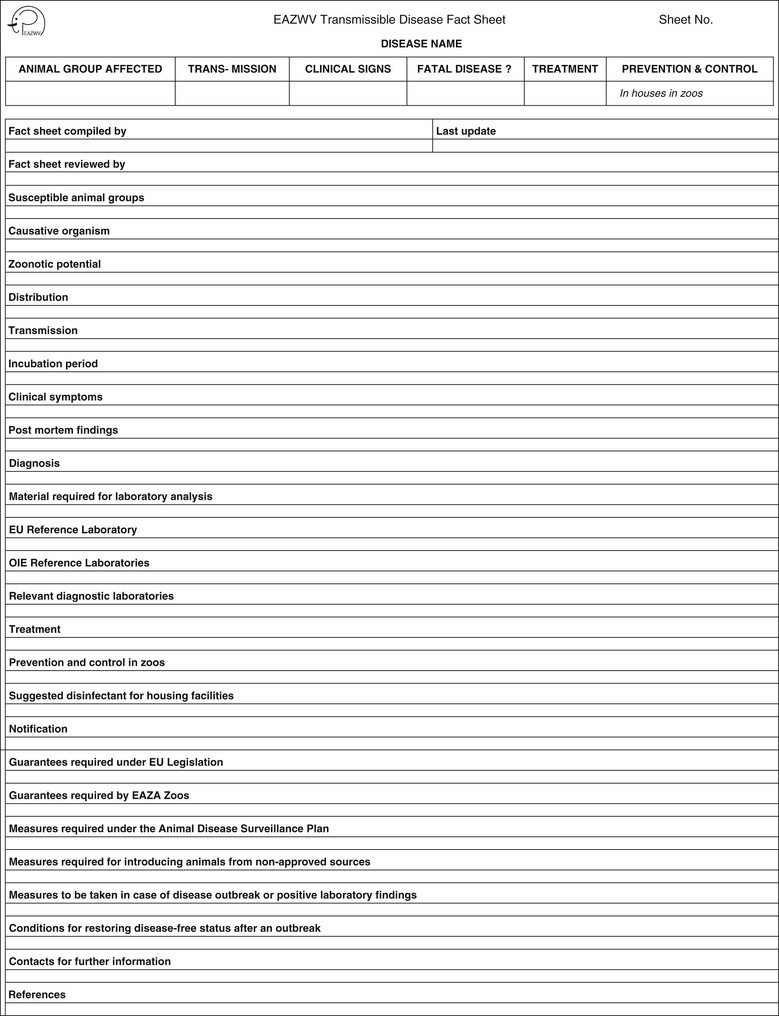Jacques Kaandorp At the 2000 European Association of Zoo and Wildlife Veterinarians (EAZWV) Congress in Paris, the establishment of an Infectious Diseases Working Group (IDWG) within the EAZWV was proposed. In North America, the American Association of Zoo Veterinarians (AAZV) already had an Infectious Disease Committee since the early 1990s. In Europe, this idea for a similar committee emerged when the problems of diagnosing and handling paratuberculosis were discussed in a presentation. It was obvious that commonly agreed recommendations were urgently needed for improved control of the infectious diseases that threatened the European collections. Also, as Europe was becoming more unified, it was necessary to deal with European politics and legislation via international collaboration. The idea to produce a comprehensive document containing disease fact sheets, legislation, laboratories, identifiable diseases, and so on resulted in the IDWG, which led to the production of the first edition of The Transmissible Diseases Handbook in May 2002 under the EAZWV-IDWG umbrella4 (Figure 68-1). The foot-and-mouth disease (FMD) outbreak in Europe in 2001 clearly underlined the importance of this initiative and made agreement on European standards a matter of even greater urgency. During this outbreak, the difficulties in controlling diseases in domesticated animals was realized; public opinion, politics, money, limited knowledge of the disease, and lack of agreement on legislation all contributed to this situation. It became obvious that even more misunderstandings would arise when dealing with such diseases in lesser-studied animals, including nondomestic species. In 2006, the highly pathogenic avian influenza spread across Europe and threatened zoo collections. Outbreaks of classic swine fever also occurred. Additionally, blue tongue disease created serious problems in transporting hoof stock and thus jeopardized organized programs for breeding endangered species.5 African swine fever, West Nile virus (WNV), African horse sickness, and monkeypox also threatened zoologic collections. The severe acute respiratory syndrome (SARS) epidemic (related to an animal coronavirus) confirmed these points and led to the recognition of the importance of The Transmissible Diseases Handbook. The second edition of the Handbook was published in 2004, the third edition in 2006, and the fourth edition in 2010; these updates were necessary because of the changes in threatening diseases, the changes in legislation, and the needs and demands for information expressed by its readers.2,3,4,6 European laws (e.g., the Balai Directive1) are still under discussion and in development. Differing opinions (e.g., whether or not to vaccinate against FMD and avian influenza), various levels of veterinary faculties and laboratories, and thus differences in the rates of successful diagnoses, pose further problems for European zoo veterinarians. Since The Transmissible Diseases Handbook is a living document and because of all these changes a fifth edition will be produced in 2014. The IDWG brings together experienced zoo veterinarians and specialists in infectious diseases from several European countries and from around the world. The idea of the Group is to combine knowledge to deal more effectively with future disease outbreaks that may threaten zoo collections. The effort to create a reference manual published under the umbrella of EAZWV was, and still is, an important step in the process of standardization for zoos in Europe, and it should provide a useful tool for zoo practitioners, zoo managers, and European legislative authorities dealing with wildlife and zoo animals. The American Association of Zoo Veterinarians (AAZV) Infectious Disease Committee (IDC) has been very active since its inception. This committee already has its own Infectious Disease Reviews Notebook published in the early 1990s. This Notebook contained loose leaf handouts, with descriptions of various diseases important for zoo veterinarians and fact sheets on the diagnostics of important diseases such as tuberculosis. After the second edition of the EAZWV-IDWG Transmissible Diseases Handbook was published in May 2004, Dr. Julie Napier, a member of the AAZV and the chair of the IDC at the time, proposed creating a handbook for infectious diseases affecting nondomestic species and wildlife in North America, using the European version as a template (see Figure 68-1). The difference between the European and American notebooks was that chapters on legislation, laboratories, web links, notifiable diseases, and so on were included in the European Transmissible Diseases Handbook, but not in the American equivalent. It was the intent of the IDC that the formatting of its manual would include more in-depth information, including etiologies, clinical signs, and treatment protocols for diseases relevant to the United States, Canada, and Mexico. Following discussions on providing a similar tool for North American veterinarians, it was agreed that the IDC could use the European disease fact sheet as a template, which provided a standardized and unified format. Thanks to the hard work of many people under the leadership of Dr. Julie Napier and Dr. Kathryn Gamble, The first American edition was published in 2011, titled Infectious Disease Manual 2011, with the subtitle “Infectious Diseases of Concern to Captive and Free-Ranging Wildlife in North America” (Boxes 68-1 and 68-2). An update of the manual was released at the end of 2013.
The EAZWV and AAZV Infectious Diseases Notebooks
History and Development of the European Transmissible Diseases Handbook
AAZV and the Infectious Disease Committee
The EAZWV and AAZV Infectious Diseases Notebooks
Chapter 68




